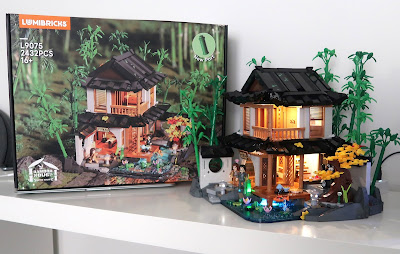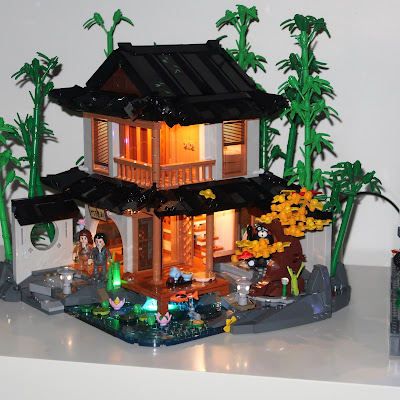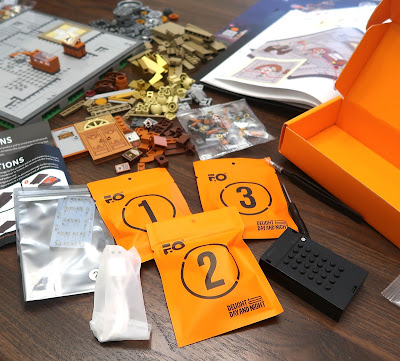Hey brick fans, if you’ve been keeping an eye on the latest Lego-compatible block brands coming out of China, you’ll probably know that Lumibricks (previously FunWhole) has been quietly making waves with their beautifully lit and thoughtfully designed sets. Their newest release, the Bamboo House, continues this trend, blending serene architecture with a touch of lighting magic.
I got my hands on this set recently, and after spending the better part of a weekend building it, I’m happy to report that Lumibricks has delivered something truly special. In this review, I’ll take you through what’s inside the box, highlight the standout features, and share my overall impressions of the set.
You can get the stunning Lumibricks Bamboo House by searching for Lumibricks on Amazon right now!
Amazon US: https://amzn.to/3YQYnZX
Amazon CA: https://bit.ly/4knp807
🏡Bamboo House
OFFICIAL website: https://www.lumibricks.com/products/bamboo-house-l9075?ref=tN9EBQmQ
** get 10% off using code itsnotlego **
What's in the Box?
The Lumibricks Bamboo House comes in a premium matte-finish box that already hints at the experience to come. Inside, you get:
-
Over 2432 pcs divided into numbered bags 1 through 11.
-
Two detailed, full-color instruction manuals
-
The signature orange box/LED lighting kit, that includes light strings, battery pack and USB connector
-
A nice selection of printed pieces including some on the window panes and doors
-
Two custom minifigs
Packaging was neat and well-protected, and I didn't have any missing pieces. To see the complete unboxing, check it out at my other blog: https://bricktoyreviews.blogspot.com/2025/05/unboxing-lumibricks-l9075-bamboo-house.html
Features That Shine (Literally)
Lumibricks used to be known as FunWhole for the past 3 years but it was time to rebrand to properly reflect the set's appeal, namely lighting with bricks. The included lighting with every Lumibricks(FunWhole) kit is the main differentiator amongs other Lego compatiuble building block brands.
In the Bamboo house, the LED light kit is subtly integrated and very easy to install. Most of the lights are hidden behind interior panels or under roof tiles, and they illuminate:
-
The stone lanterns next to the pond
The mood lighting underneath the deck
-
A cozy tea room with a glowing hearth
-
The upstairs study, which casts a soft yellow light through printed window panels
The glow gives the whole house a lived-in, evening ambiance that really brings it to life—especially if you're displaying it on a shelf or in a dimly lit room.
The Minifigures
The Lumibricks Bamboo house comes with two uniquely styled minifigures. They even come with a change of clothes for the city.Exterior Details
Interior Details
The Bamboo House isn’t just a pretty façade. The inside is fully built out and packed with small, satisfying details.
Here's the main floor.On the ground floor, you have:
-
An outdoor patio where tea is served
A work desk with miniature ink pots and a calligraphy brush
-
A room to practice playing the musical instrument called a lute
A staircase that goes up to the second floor
The second floor features:
-
A loft-style sleeping area with a futon made of smooth tile pieces
A small soaking tub in the bathroom
A covered porch with glass floor
Play features
Not only does the Bamboo house display well, there are several play features to further enhance the enjoyment of the set.
The Lighting Effect
Here are a couple of shots for you to appreciate the beautiful lighting effects of the Lumibricks Bamboo house. This is what make Lumibricks sets shine!
Final Thoughts
The Lumibricks Bamboo House is a beautiful Asian inspired modular building that gives off a tranquil vibe. This set is a no brainer If you’re into:
Architecture-style builds
-
Tranquil, slice-of-life scenes
-
Asian aesthetics
-
Or simply want a display piece that stands out from typical brick sets…
Rating: 9/10
Pros:
✅ Beautiful bamboo forest feature
✅ Easy-to-install lighting kit
✅ Fully furnished interior
That’s it for this review! If you’ve built the Bamboo House or any other Lumibricks sets, drop a comment or shoot me a message—I’d love to hear what you thought.
Happy building! 🧱✨
Bye and see you next time!




























































